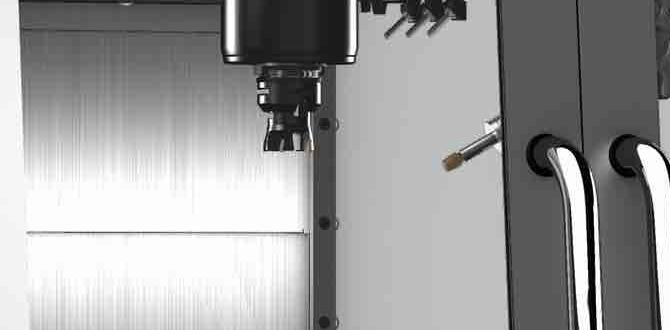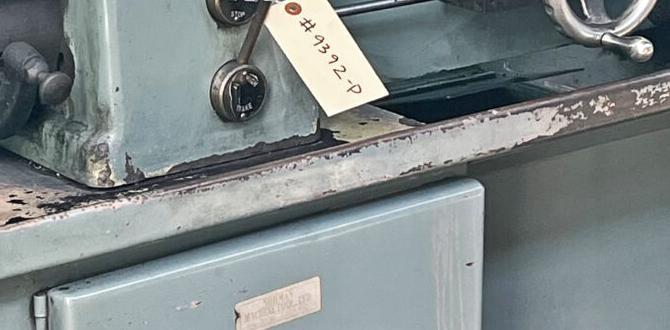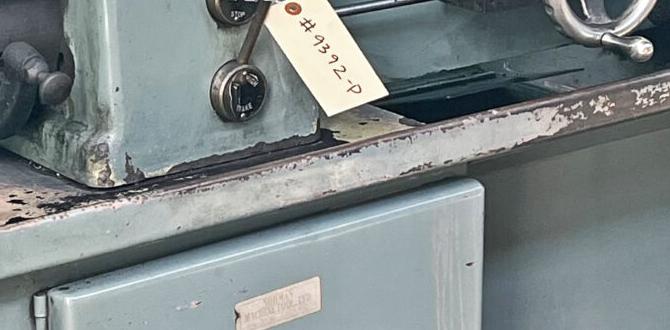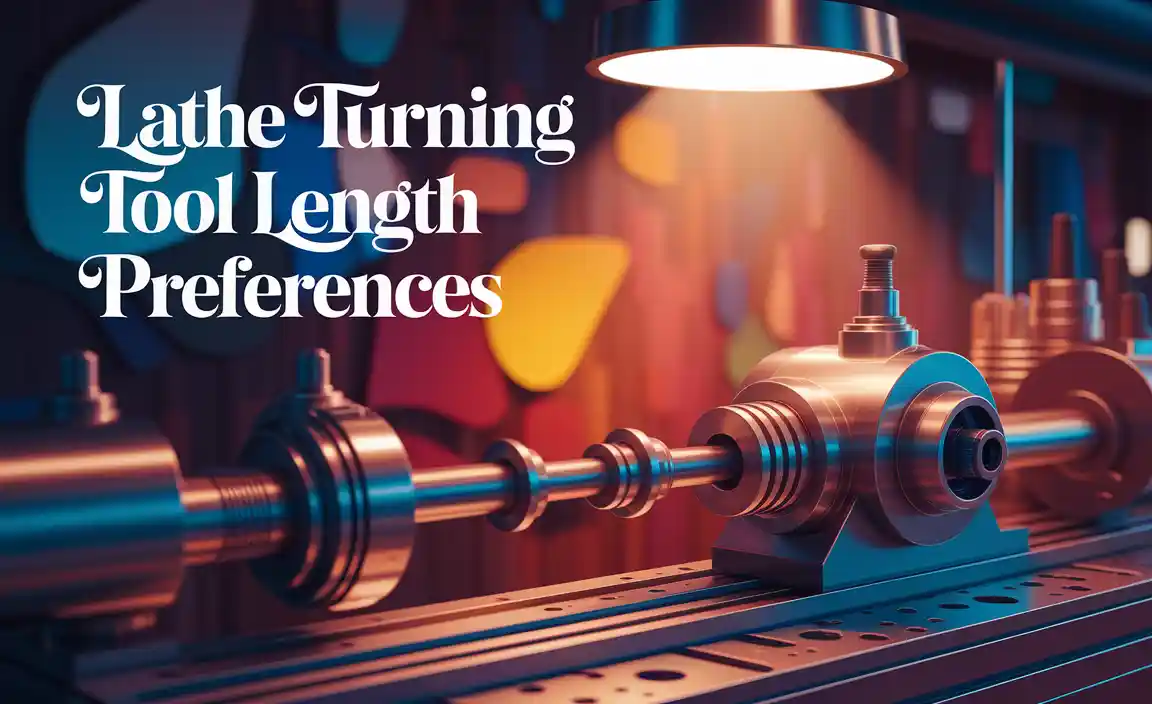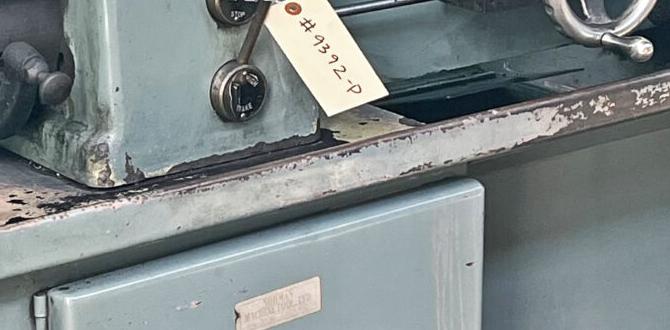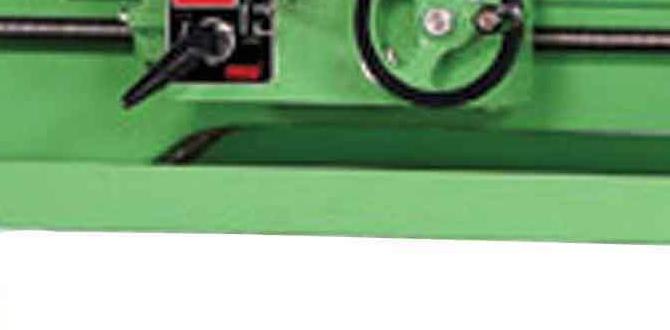Have you ever wondered how a lathe machine works perfectly? It all starts with the lathe headstock alignment process. This step is key to making sure your machine cuts smoothly and accurately.
Imagine trying to draw a straight line with a broken ruler. Frustrating, right? That’s how it feels when the headstock isn’t aligned properly. Many beginning machinists face this problem. Gaining a deep understanding of lathe headstock alignment can make all the difference.
Did you know that a well-aligned lathe can improve the quality of your work? It can help you create better pieces and avoid costly mistakes. Proper alignment can also extend the life of your machine. Learning about this process is not just useful; it can be fun and rewarding!
Understanding The Lathe Headstock Alignment Process: A Guide
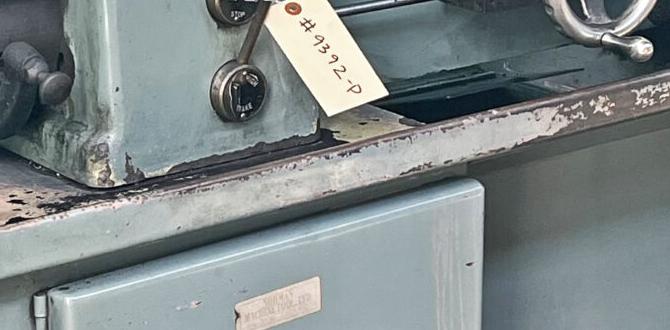
Understanding the Lathe Headstock Alignment Process
Aligning the headstock of a lathe is crucial for accurate machining. Proper alignment ensures the tool cuts thoroughly and prevents wear. Misalignment can lead to errors and costly mistakes. Did you know that even a tiny misalignment can ruin a project? The process involves measuring distances, adjusting the headstock, and rechecking alignment. Simple tools can help anyone learn to align a lathe effectively. Understanding this can greatly improve your skills and results in woodworking or metalworking.Understanding Lathe Headstocks
Definition and function of a lathe headstock. Components of the headstock and their roles in machining.A lathe headstock is an essential part of a lathe machine. It holds the spindle, which rotates the workpiece. The headstock controls speed and movement for precise machining. Key parts of the headstock include:
- Spindle: Spins the workpiece.
- Gearbox: Adjusts speed and torque.
- Chuck: Holds the work tightly.
- Bearings: Support smooth rotation.
These components work together to ensure accurate shaping of materials like wood and metal. Understanding them helps in using a lathe safely and effectively.
What is a lathe headstock used for?
The lathe headstock is used to hold and rotate the workpiece, playing a critical role in machining tasks.
The Importance of Headstock Alignment
Effects of misalignment on machining accuracy. Longterm consequences of improper headstock alignment.Headstock alignment matters in machining. If it’s off, parts can come out uneven or wrong. This can cause:
- Poor quality of work
- Increased wear on tools
- Higher costs for repairs
Over time, bad alignment can lead to serious problems. Machines can break down more often, which costs money and time. Fixing these issues early can save much trouble later.
Why is headstock alignment crucial?
Misalignment can lead to errors that pile up, causing wasted materials and frustration for operators.
Tools Required for Headstock Alignment
Common alignment tools and their uses. Measurement devices for accuracy verification.Aligning a lathe headstock takes some nifty tools. First on the list is a dial indicator, perfect for checking how level your headstock is. Next, you’ll want a straightedge to find out if those surfaces are actually straight—because nobody likes a wobbly lathe! For the math whizzes out there, a feeler gauge helps measure tight gaps, while a laser alignment tool brings the high-tech flair. Use these tools, and your lathe will be as aligned as your socks after laundry day!
| Tool | Use |
|---|---|
| Dial Indicator | Measures headstock level |
| Straightedge | Checks surface flatness |
| Feeler Gauge | Measures narrow gaps |
| Laser Alignment Tool | High-tech alignment verification |
Step-by-Step Headstock Alignment Process
Initial setup and preparation. Detailed procedure for aligning the headstock.Start by making sure your workspace is tidy. Gather tools like a level, measuring tape, and a wrench. These will help you in the lathe headstock alignment process.
Next, follow these steps:
- Place a level on the lathe bed. Check if it is straight.
- Measure the distance from the headstock to the tailstock. Adjust if necessary.
- Use the wrench to tighten bolts. Ensure that everything is snug.
- Recheck the level after adjustments.
These steps will help align your headstock properly. A well-aligned headstock leads to smoother operations. Remember, accuracy is key in any alignment work!
Why is headstock alignment important?
Correct alignment ensures better cutting precision and reduces wear on tools.
What tools do I need for alignment?
- Level
- Measuring tape
- Wrench
Common Issues During Alignment
Potential pitfalls and how to avoid them. Troubleshooting misalignment problems.Aligning a lathe headstock can feel like juggling flaming torches. One slip, and chaos reigns! Common problems include uneven surfaces or worn bearings. To dodge these issues, always check for levelness and wear and tear before starting. If you notice vibrations or noise, it’s time for some troubleshooting. Adjust, tighten, or replace parts as needed. Remember: it’s easier to fix minor problems than to solve major disasters down the road!
| Issue | Solution |
|---|---|
| Uneven Surface | Check and level the base. |
| Worn Bearings | Replace with new bearings. |
| Vibrations | Tighten connections. |
Regular Maintenance and Checks
Importance of periodic alignment checks. Recommended maintenance practices for headstocks.Keeping machines in top shape is very important. Regular alignment checks can help keep your lathe running smoothly. This practice can prevent costly repairs and enhance the quality of your work. Here are some recommended steps:
- Check the alignment every few weeks.
- Clean the headstock regularly.
- Lubricate moving parts.
- Inspect for wear or damage.
Following these steps can lead to better performance and a longer life for your lathe.
Why is periodic alignment important?
Periodic alignment keeps the lathe accurate and efficient. This helps avoid mistakes in the work and saves time.
Case Studies and Real-World Applications
Examples of successful headstock alignment. Impact of alignment on production efficiency.Various industries benefit from successful headstock alignment. In one case, a machine shop improved its output by 30% after adjusting alignment. Proper alignment reduces wear on tools and machines, leading to longer tool life. This means less money spent on replacements.
- Alignment improves accuracy in parts.
- Better precision in machining can boost profit margins.
Studies show correct alignment can save time and materials. This helps factories run smoothly.
How does headstock alignment impact production efficiency?
Headstock alignment enhances overall efficiency. It lowers machine errors and cuts downtime, leading to faster production rates. Accurate alignment creates high-quality products, pleasing customers and increasing sales.
Conclusion
In summary, the lathe headstock alignment process is crucial for accurate machining. You should check the alignment often. Use simple tools to make adjustments as needed. Remember, proper alignment improves your work and extends machine life. If you want to learn more, consider reading guides or watching videos on alignment techniques. Your projects will benefit from the extra knowledge!FAQs
Certainly! Here Are Five Questions Related To The Lathe Headstock Alignment Process:Sure! Here are some answers to questions about aligning the lathe headstock: 1. Why is it important to align the lathe headstock? It’s important to align the headstock so machines work correctly. This helps make smooth cuts and shapes. 2. What tools do we need for headstock alignment? You might need a ruler, a level, and a set square. They help us check if everything is straight. 3. How do we know if the headstock is out of alignment? If we see uneven cuts or a wobbly piece, the headstock might be off. We should check it again. 4. How often should we check headstock alignment? We should check it regularly, especially after moving the lathe. This keeps our work accurate and safe. 5. What happens if we don’t align the headstock? If we don’t align it, our projects can be messy. Machines can break or work slowly, too.
Sure! Please provide the question you’d like me to answer, and I’ll help you out.
What Are The Primary Indicators Of Misalignment In A Lathe Headstock, And How Can They Be Detected?If a lathe headstock is not aligned, you might see a few signs. The machine could make weird noises as it runs. Workpieces might be uneven or wobble while spinning. You can check for misalignment by measuring with a ruler or a special tool. If things look crooked or feel off, it’s a sign that something’s wrong.
What Tools And Equipment Are Commonly Used To Achieve Precise Alignment Of The Lathe Headstock?To align the lathe headstock, we use a few important tools. A dial indicator helps us measure tiny changes in position. You might also use a level to check if everything is straight. Finally, a precision square helps us ensure right angles. These tools help us make sure our lathe works perfectly!
What Step-By-Step Procedure Should Be Followed To Align The Headstock Correctly On A Lathe Machine?To align the headstock on a lathe machine, follow these steps. First, turn off the machine for safety. Next, check if the headstock is level by using a small level tool. If it’s not, adjust it by turning the screws underneath. Finally, double-check that it’s straight before starting any work.
How Often Should Lathe Headstock Alignment Be Checked And Adjusted To Maintain Optimal Performance?You should check the lathe headstock alignment every few months. If you notice any problems while using it, check sooner. Regular checks help keep everything running smoothly. Adjusting it when needed helps your lathe work better and last longer.
What Are The Potential Consequences Of Improper Headstock Alignment On The Machining Process And Workpiece Quality?If the headstock is not aligned correctly, the machine can make mistakes. You might end up with a workpiece that is uneven or not the right size. This can waste materials and make your project take longer. You might also have to fix mistakes, which can be frustrating. In the end, it can mean a lot more work for you!
{“@context”:”https://schema.org”,”@type”: “FAQPage”,”mainEntity”:[{“@type”: “Question”,”name”: “Certainly! Here Are Five Questions Related To The Lathe Headstock Alignment Process: “,”acceptedAnswer”: {“@type”: “Answer”,”text”: “Sure! Here are some answers to questions about aligning the lathe headstock: 1. Why is it important to align the lathe headstock? It’s important to align the headstock so machines work correctly. This helps make smooth cuts and shapes. 2. What tools do we need for headstock alignment? You might need a ruler, a level, and a set square. They help us check if everything is straight. 3. How do we know if the headstock is out of alignment? If we see uneven cuts or a wobbly piece, the headstock might be off. We should check it again. 4. How often should we check headstock alignment? We should check it regularly, especially after moving the lathe. This keeps our work accurate and safe. 5. What happens if we don’t align the headstock? If we don’t align it, our projects can be messy. Machines can break or work slowly, too.”}},{“@type”: “Question”,”name”: “”,”acceptedAnswer”: {“@type”: “Answer”,”text”: “Sure! Please provide the question you’d like me to answer, and I’ll help you out.”}},{“@type”: “Question”,”name”: “What Are The Primary Indicators Of Misalignment In A Lathe Headstock, And How Can They Be Detected?”,”acceptedAnswer”: {“@type”: “Answer”,”text”: “If a lathe headstock is not aligned, you might see a few signs. The machine could make weird noises as it runs. Workpieces might be uneven or wobble while spinning. You can check for misalignment by measuring with a ruler or a special tool. If things look crooked or feel off, it’s a sign that something’s wrong.”}},{“@type”: “Question”,”name”: “What Tools And Equipment Are Commonly Used To Achieve Precise Alignment Of The Lathe Headstock?”,”acceptedAnswer”: {“@type”: “Answer”,”text”: “To align the lathe headstock, we use a few important tools. A dial indicator helps us measure tiny changes in position. You might also use a level to check if everything is straight. Finally, a precision square helps us ensure right angles. These tools help us make sure our lathe works perfectly!”}},{“@type”: “Question”,”name”: “What Step-By-Step Procedure Should Be Followed To Align The Headstock Correctly On A Lathe Machine?”,”acceptedAnswer”: {“@type”: “Answer”,”text”: “To align the headstock on a lathe machine, follow these steps. First, turn off the machine for safety. Next, check if the headstock is level by using a small level tool. If it’s not, adjust it by turning the screws underneath. Finally, double-check that it’s straight before starting any work.”}},{“@type”: “Question”,”name”: “How Often Should Lathe Headstock Alignment Be Checked And Adjusted To Maintain Optimal Performance?”,”acceptedAnswer”: {“@type”: “Answer”,”text”: “You should check the lathe headstock alignment every few months. If you notice any problems while using it, check sooner. Regular checks help keep everything running smoothly. Adjusting it when needed helps your lathe work better and last longer.”}},{“@type”: “Question”,”name”: “What Are The Potential Consequences Of Improper Headstock Alignment On The Machining Process And Workpiece Quality?”,”acceptedAnswer”: {“@type”: “Answer”,”text”: “If the headstock is not aligned correctly, the machine can make mistakes. You might end up with a workpiece that is uneven or not the right size. This can waste materials and make your project take longer. You might also have to fix mistakes, which can be frustrating. In the end, it can mean a lot more work for you!”}}]}
